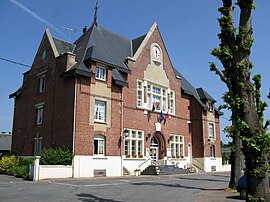Vermand
Appearance
You can help expand this article with text translated from the corresponding article in French. (December 2008) Click [show] for important translation instructions.
|
Vermand | |
|---|---|
 Town hall | |
| Coordinates: 49°52′N 3°09′E / 49.87°N 3.15°E | |
| Country | France |
| Region | Hauts-de-France |
| Department | Aisne |
| Arrondissement | Saint-Quentin |
| Canton | Saint-Quentin-1 |
| Intercommunality | Pays du Vermandois |
| Government | |
| • Mayor (2020–2026) | Jean-Pierre Boniface[1] |
| Area 1 | 15.75 km2 (6.08 sq mi) |
| Population (2021)[2] | 1,101 |
| • Density | 70/km2 (180/sq mi) |
| Time zone | UTC+01:00 (CET) |
| • Summer (DST) | UTC+02:00 (CEST) |
| INSEE/Postal code | 02785 /02490 |
| 1 French Land Register data, which excludes lakes, ponds, glaciers > 1 km2 (0.386 sq mi or 247 acres) and river estuaries. | |
Vermand (French pronunciation: [vɛʁmɑ̃]; Picard: Vermind) is a commune in the Aisne department in Hauts-de-France in northern France.
Vermand was probably the original capital of the Viromandui, after whom the region of Vermandois is named. It was later displaced by the Roman settlement of Augusta Viromanduorum, modern Saint-Quentin.[3]
Population
[edit]| Year | Pop. | ±% |
|---|---|---|
| 1962 | 998 | — |
| 1968 | 1,135 | +13.7% |
| 1975 | 1,165 | +2.6% |
| 1982 | 1,163 | −0.2% |
| 1990 | 1,118 | −3.9% |
| 1999 | 1,069 | −4.4% |
| 2008 | 1,036 | −3.1% |
See also
[edit]References
[edit]- ^ "Répertoire national des élus: les maires". data.gouv.fr, Plateforme ouverte des données publiques françaises (in French). 2 December 2020.
- ^ "Populations légales 2021" (in French). The National Institute of Statistics and Economic Studies. 28 December 2023.
- ^ Jean-Luc Collart and Michèle Gaillard, [http
- //www.persee.fr/doc/sracf_1159-7151_2004_act_25_1_1220 "Vermand /Augusta Viromanduorum (Aisne)"], Supplément à la Revue archéologique du centre de la France, 25, 1 (2004): 493–96.
Wikimedia Commons has media related to Vermand.




